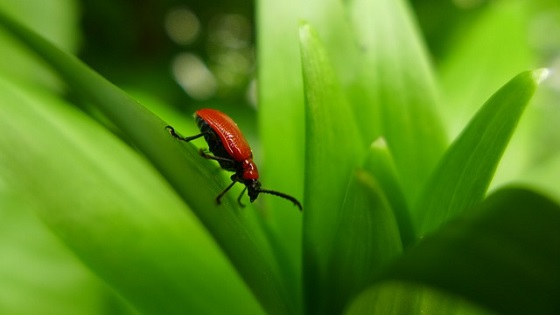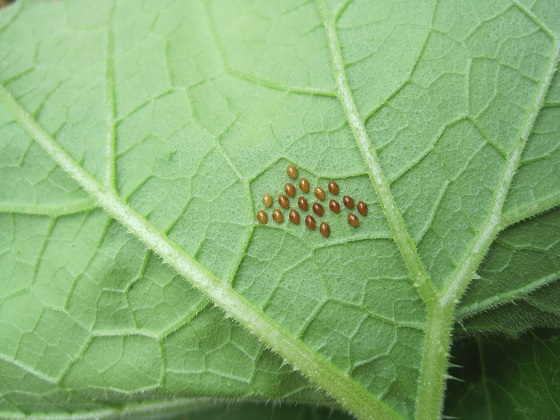
Japanese Beetles, Squash Bugs, and More
Become a better gardener! Discover our new Almanac Garden Planner features for 2024. It’s easy, fun, and free to try!
ADVERTISEMENT
Anyone have real time experience? I hear it's really effective.
I usually collect Japanes beetles in a wide-mouth jam jar, but the larger milk bottle sounds better.
I rarely have an adult squash bug in the garden because I check the leaves once a week (it takes a few days longer than that for them to hatch) and cut the little piece where the eggs are out of the leaf and throw it in the trash.
As for cucumber beetles, I have a wonderful new way to catch them. I happen to have a jar of Tanglefoot, which is sticky but otherwise inert, and I dip the big end of a flat wooden toothpick in it, reach into a squash or cucumber blossom, pick up the beetle (or couple), and drop it, stick and all, into a jar of soapy water.
Chopping bugs and larvae in half with small scissors sounds good, especially for bigger bugs that might be able to escape the Tanglefoot.
Is there some kind of master chart that has photos or drawings of all life stages for every kind of bug, both detrimental and beneficial? Or a good book that covers most of them?
I am familiar with some of the adults, but at a loss as to what eggs and larva go with what adult.
I, too, have the beetle/weevil problem. This year I have seen a larger population of Sri-Lanka Weevils--they seem to attack anything--Lime trees, Avocados, Okra, Eggplant. Fortunately, they have the same habit of falling straight down when disturbed--I use a peanut butter jar with ~ 1/2" of soapy water--easier to get in amongst the foliage. This works for stink bugs too--but they tend to fly away if you disturb them too much--I've been using a small pair of scissors to chop them in half--the scissors are small enough that they don't seem to see it coming(like a big hand with fingers)
Here in semi-arid climate, we have grasshopers, wasps and earwigs. They eat and make holes in everything. Especially the grasshoppers. No one seems to have a solution. Any organic ideas??
A petition is going around to the government to do something, but what can they do but spray all of us, our land and gardens with a chemical that could be bad for the dogs and cattle etc.
Grasshoppers are voracious eaters. There are several organic methods which might help to make a dent in your population.
Foster predators such as snakes, toads, cats, skunks, birds, chickens, ducks, Guinea hens, and praying mantids. They all are known to eat adult and juvenile grasshoppers.
Use barriers such as row covers or cones made from aluminum screening.
Try interplanting your crops with repellent plants. Grasshoppers don't like cilantro, horehound, or calendula.
Use repellent sprays made from garlic oil, hot peppers, strong coffee, or neem oil.
Make a grasshopper trap from 10 parts water to 1 part molasses in a half-buried jar. They will be attracted to the sweet molasses smell and drown in the water.
Dust plants with diatomaceous earth which has microscopic sharp edges that will slice and dice your grasshoppers.
Try the natural fungus Nosema locustae sold as Nolo bait or Semaspore. It weakens and eventually kills grasshopers that eat it and will eventually take a toll on the population.
Good Luck!
I have red beetles and something that looks like a tiny black slug in one section of my garden wall that attack everything I try to grow there. They really like my Asiatic lilies. They weaken and destroy everything I try to grow there. What massive effort can I use to get rid of them in that section. Love the smell of the lilies under the bedroom window and can't enjoy a single one.
That's the lily leaf beetle and the slug-like thing is its larvae. We grow several beds of Asiatic and Oriental lilies to sell to florists so they have to be pristine. We start patrolling for the beetles as soon as the lilies emerge from the soil in the spring and Tom checks them daily for new beetles and larvae, squishing as he goes. If you can't stomach the squish then drop them into soapy water. It might be too late for this year's flowers but start early next year to stay ahead of the infestation.
Any recommendations for keeping praying manthis at bay? Over-loaded with them. They destroy everything. They eat the good bugs and they are killing my garden.
I agree with Rose. I wish I had them too! Praying mantises are predatory and only eat other insects - good and bad they don't discriminate. I have never heard of them destroying plants.















